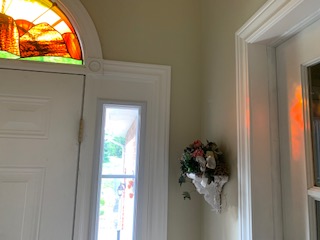

Every year, about a month before summer solstice, the sun directs light toward our front door from the northwest. It lasts about two months before the inexorable tilt of the earth pulls the light shafts away for another year. The refraction of its rays through the chariots of fire stained glass has a mystical feel, the light dancing like flames. Each year this is a welcome reminder of another year of earth-time we’ve been given.
Light is fascinating, its spectrum far beyond what we are able to visually comprehend. A pool of sunlight on a winter’s day invites basking. In summer, we watch the beams dapple through the leaves of the trees, light and shadows forever shifting in the breeze, or sparkling on a lake. A favourite spot for morning quiet time is the kitchen table, as I watch the sun begin its day’s journey in the east. The ever-changing colours when the sun sets at days’ end calls me to vigil with the evening sky, riveted by the spectacle. Through the night, the moon dangles in the sky like a pendant, stars twinkle like jewels against the black-velvety backdrop.
Rachel Naomi Remen writes of the time when she was a young volunteer in a nursing home, sent to entertain a very old woman with senile dementia, Finally giving up on interesting her in any activity, Rachel just sat quietly with her as she looked out the window. But before she left, her curiosity compelled her to ask the old woman what she was looking at. “Slowly, she turned toward me and I could see her face for the first time.. It was radiant. In a voice filled with joy she said, “Why, child, I am looking at the Light.”
Light was created by God, both the sun and other heavenly bodies that he caused to reflect it. In response to the greater Light, human beings can also be light bearers, carrying a spark of the Divine. In worship, we light a candle when we open God’s Word, symbolizing the light that it kindles in our souls. As God called forth light on the first day of creation, so he speaks it into our darkness and chaos.
Our vocabulary is full of light’s reflections. A person can light up a room. We can be enlightened so that we can see the bigger picture. We reflect on our experiences. We use the picture of a lightbulb for the eureka moment, the spark of an idea. We can let our light shine, turn on our “heart light.” At my grandfather’s funeral, the officiating minister remarked that though our Opa had become blind, when he turned his sight inward he found beauty inside his soul. If we let it, a light can increasingly glow through our frailties.
“Frodo (from Lord of the Rings) has no superficially heroic dimensions. He simply goes on from one day to the next, through despair and beyond it, and as he goes, Sam sees a kind of light growing within his master.” Helen Luke
The Irish poet Patrick Kavanagh expresses his desire that the young view light, not only in creation, but also follow that lit pathway to see God. His poem is called “The Child.”
“Child, there is a light somewhere
Under a star
Sometime, it will be for you
A window that looks
Inward to God.”

